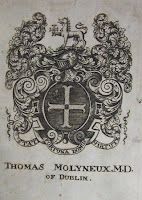Irish Medical Bookplates
Working though some of the College's own archive I came across this rather lovely collection of about forty bookplates, mostly of Irish medical men, which seem to have been collected by Dr Kirkpatrick. Thomas Percy Claude Kirkpatrick (1869-1954) was registrar of the College for over 40 years in the first half of the twentieth century, and was extremely interested in the history of his profession and the College. It was Kirkpatrick who collected newspaper cuttings and biographical material on over 10,000 Irish born doctors, which is one of the most important sources for biographical details of Irish doctors.
Bookplates originated in Germany shortly after the invention of printing. In an age when books were an extremely rare and valuable commodity it is perhaps unsurprising that owners wanted to make possession clear. Throughout the eighteenth and nineteenth century as books became more widespread, so did the use of book plates. In Bookplates of Irish Medical Doctors Edward Martin, another Fellow of the College, suggests that the first bookplate in Ireland may well have been that of Sir Thomas Molyneux.

Molyneux (1661-1733) was one of the wealthiest medical practitioners in Dublin of his day and President of the College four times between 1702 and 1720. His bookplate, included in Kirkpatrick's collections shows an early Jacobean armorial crest and motto
Stat Fortuna Domus Vistute (The fortune of our house stands by virtue).
[1]
Another early bookplate in the collection is that of John Stearne (1660-1745) Church of Ireland Bishop of Clogher and son of John Stearne (1624-1669) founder of the College. The bookplate shows Stearne's coat of arms, topped by a bishop's mitre, and was obviously designed to mark his translation to the bishopric of Clogher in 1717.
Francis Hopkins' bookplate shows his armorial shield in a picturesque landscape surrounded by trees and foliage. The shield is supported by books, manuscripts and a globe presumable signifying learning. The rather belligerent shield which shows three pistols and is topped by a burning castle, is accompanied by the more pacifistic motto Suavitate aut vi (by agreeableness rather than aggression). Hopkins (1752-1819) was the first practitioner in midwifery to gain a licence from the College.[2]
The final plate I've selected is that of Ephraim MacDowel Cosgrave (1853-1925). Cosgrave seems to have been a fan of bookplates and Martin's book contains eight different plates designed for Cosgrave in various styles. This one was designed to commemorate Cosgrave's time as President of the College from 1914 to 1916. The bookplate shows the original coat of arms of the College with the celestial hand taking the pulse of the temporal hand, over the harp of Ireland. The design of the College arms had to be changed after the 1800 Act of Union to include the British crown over the Irish harp and the temporal hand was lost.
Despite Kirkpatrick's interest in books and bookplates, and the substantial bequest of medical works he gave to the College, it doesn't seem that he had a bookplate made for his own collection.
[1] Martin, Edward A, Bookplates of Irish Medical Doctors (Dublin, 2003), pp. vi-vii and 92-3.
[2] ibid, p.62